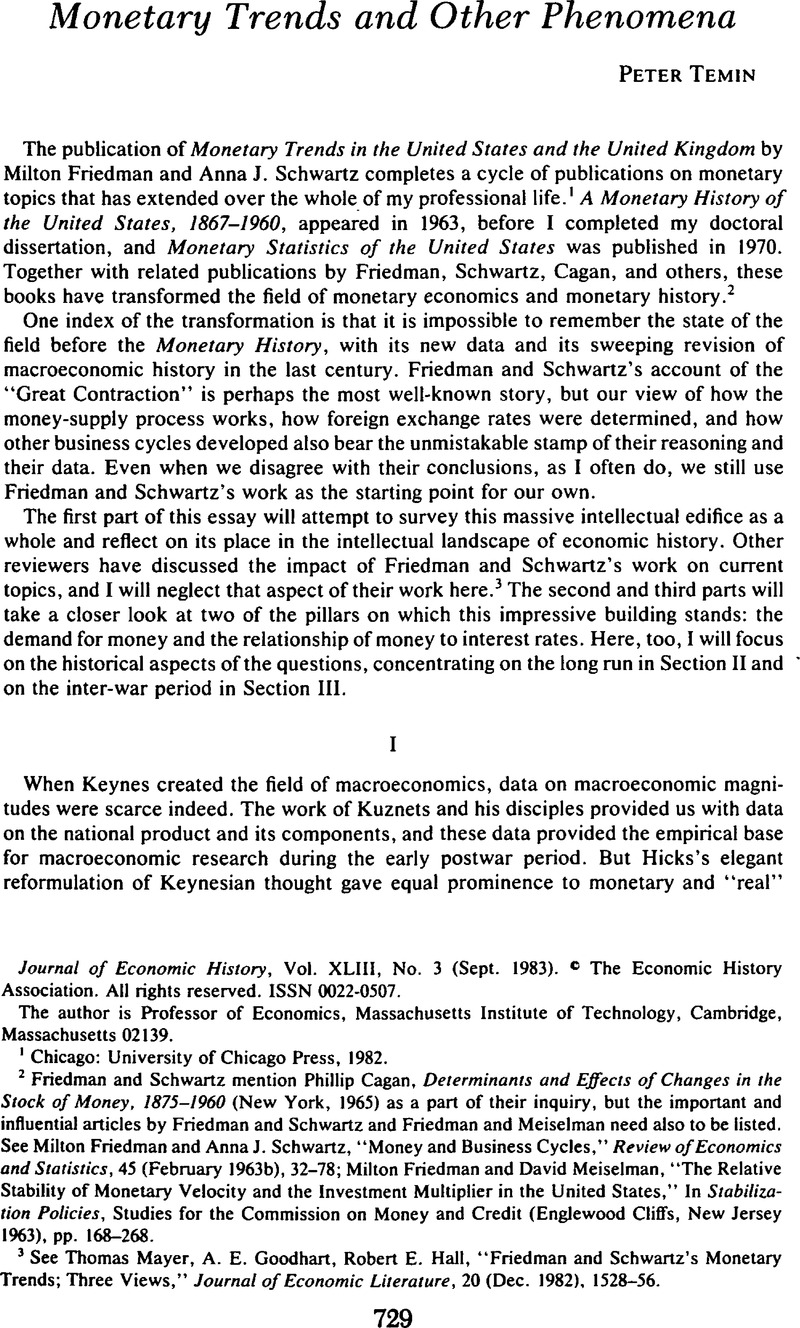Published online by Cambridge University Press: 03 March 2009

1 Chicago: University of Chicago Press, 1982.Google Scholar
2 Friedman, and Schwartz mention Phillip Cagan, Determinants and Effects of Changes in the Stock of Money, 1875–1960 (New York, 1965) as a part of their inquiry, but the important and influential articles by Friedman and Schwartz and Friedman and Meiselman need also to be listed.Google Scholar
See Friedman, Milton and Schwartz, Anna J., “Money and Business Cycles,” Review of Economics and Statistics, 45 (02 1963b), 32–78;CrossRefGoogle ScholarFriedman, Milton and Meiselman, David, “The Relative Stability of Monetary Velocity and the Investment Multiplier in the United States,” In Stabilization Policies, Studies for the Commission on Money and Credit (Englewood Cliffs, New Jersey 1963), pp. 168–268.Google Scholar
3 See Mayer, Thomas, Goodhart, A. E., Hall, Robert E., “Friedman and Schwartz's Monetary Trends; Three Views,” Journal of Economic Literature, 20 (12. 1982), 1528–56.Google Scholar
4 Hicks, J. R., “Mr. Keynes and the Classics: A Suggested Interpretation,” Econometrica, 5 (1937), 147–59.CrossRefGoogle Scholar
5 Friedman, Milton, “The Role of Monetary Policy,” American Economic Review, 58 (03. 1968), 1–17.Google Scholar
6 See Gordon, Robert J., “Price Inertia and Policy Ineffectiveness in the United States, 1890–1980,” Journal of Political Economy, 90 (12. 1982), 1087–1117, for an unsympathetic review of this literature.CrossRefGoogle Scholar
7 Monetary Trends, pp. 629–30.Google Scholar
8 Goldfeld, S. M., “The Demand for Money Revisited,” Brookings Papers, 3 (1973), 576–638.Google Scholar
9 Cooley, T. F. and LeRoy, S. F., “Identification and Estimation of Money Demand,” American Economic Review, 71 (12. 1981), 825–44.Google Scholar
10 Monetary Trends, pp. 621–32.Google Scholar
11 Ibid., p. 15.
12 Ibid., p. 282.
13 Ibid., pp. 274–76.
14 Schwartz, Anna J., “Understanding 1929–1933,” in Brunner, Karl, ed., The Great Depression Revisited (Boston, 1982), pp. 5–48.Google Scholar
15 Monetary Trends, pp. 216–21. The annual series for the stock of money they list, pp. 121ff, is unadjusted, but the smoothed series, pp. 185ff, is the revised version.Google Scholar
16 The rather confusing description of these shift terms is in Monetary Trends, pp. 248–50, 280–81.Google Scholar
17 The constant term in their equation had a negative sign which was omitted by mistake in Table 6–14, p. 282. Following Friedman and Schwartz, the rates of return are expressed as decimals, rather than as the percentages shown on pp. 121ff and 185ff. The remaining differences appear to be rounding errors.
18 Monetary Trends, p. 245.Google Scholar
19 I cannot resist responding to Friedman and Schwartz's challenge in their footnote on p. 33, where they accuse me of confusing the demand for real and for nominal money balances in my analysis of the Great Depression. They suggest an annotated version of one of my summary statements. Let me give my own version, where the bracketed words have been added here: “There is nothing in Chapter 7 of the Monetary History to refute the following story: [Real] income [prices] and production fell from 1929 to 1933 for nonmonetary reasons. Since the demand for [real] money [balances] is a function of [real] income, the demand for [real] money [balances] fell also. To equilibrate the money market, either interest rates, the [nominal] stock of money, or both, had to fall. And since the [nominal] supply of money was partly a function of the interest rate, this movement down the supply curve of [nominal] money meant a decrease in both [interest rates and the nominal stock of money].”
See my essay in Brunner, , The Great Depression Revisited, for a more complete statement which additionally distinguishes between real and nominal interest rates.Google Scholar
20 Monetary Trends, pp. 477–500, 574–77.Google Scholar
21 Mishkin, Frederic S., “Monetary Policy and Short-Term Interest Rates: An Efficient Markets-Rational Expectations Approach,” Journal of Finance, 37 (03. 1982), 63–72.Google Scholar
22 Monetary Trends, p. 622.Google Scholar
23 See Friedman and Meiselman, “The Relative Stability of Monetary Velocity.”
24 Adding time to these regressions to correct for the trend in the stock of money changes the coefficients slightly, but makes no important difference either in the size of the coefficients or in hypothesis testing.
25 I am indebted to Barry Eichengreen for raising this question.
26 It stretches the imagination to use a single estimating equation for the predicted money stock for the entire interwar period, since it appears to imply foreknowledge of the Depression. One cannot reject the hypothesis that the autoregressive equation stays the same throughout these years, so I have nonetheless used a single equation.
27 Did Monetary Forces Cause the Great Depression? (New York, 1967).Google Scholar